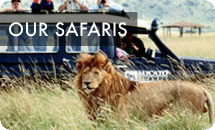Lake Manyara




 My Safari
My SafariCall a specialist to talk about Lake Manyara now.
Lake Manyara National Park is a small spectacular park of 325sq km situated between the Great Rift Valley escarpment and Lake Manyara, a shallow alkaline lake supporting thousands of flamingo. The best known feature of Lake Manyara National Park is its legendary tree-climbing lions. It also has hot springs which originate from rainfall in the mountains. It has varied vegetation from marshland and reed beds to open grassland and acacia woodland and a diversity of wildlife to match, including blue monkeys, baboons, hippo, buffalo, zebra and elephant. The broken forests and escarpment also make it good country for leopard. Huge troops of baboons - possibly Africa's largest density of this particular animal - are an obvious feature. Birding is well catered for here as well.
Being only a short drive, both from the town of Arusha and also from the Ngorongoro Crater, the area can suffer from heavy game viewing traffic (it is also increasingly encroached upon by human settlement), which can detract from its appeal to some extent.
Wildlife Highlights:
-
The legendary tree-climbing lions (not to mention tree-climbing pythons - interesting!)
-
Buffalo
-
Elephant
-
Giraffe
-
Hippo
-
Zebra
-
Wildebeest, Bushbuck & Reedbuck
Lake Manyara also provides the perfect introduction to Tanzania’s birdlife. More than 400 species have been recorded, and even a first-time visitor to Africa might reasonably expect to observe 100 of these in one day. Highlights include thousands of pink-hued flamingos on their perpetual migration, as well as other large waterbirds such as pelicans, cormorants and storks.
Getting to Lake Manyara:
Lake Manyara is a two hour drive, or half hour flight, from Arusha, often undertaken en route to Serengeti and the Ngorongoro Crater. The entrance gate is close to the ethnically diverse market town of Mto wa Mbu.
The best time to visit is in the dry season (July-October) for large mammals, or in the wet season (November-June) for bird watching, the waterfalls and canoeing. Mountain biking is a further option during the dry season.
A particularly interesting feature is the hot springs which are fed by ground water originating in the highlands, and which are heated by the action of the RV volcanic system on their way underground through the bedrock to the actual springs, picking up salt and sulphur on the way - a natural spa.





